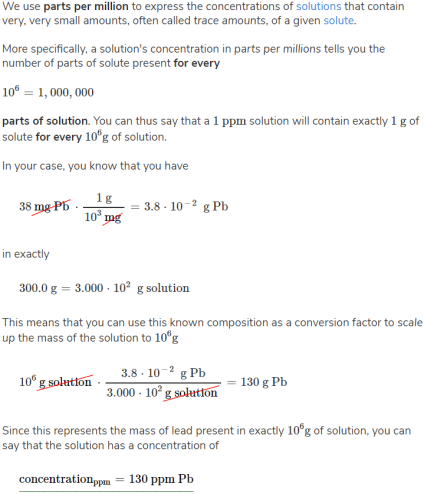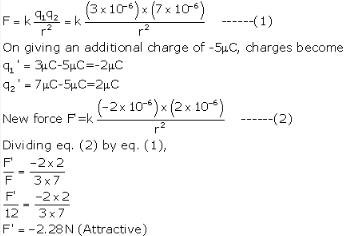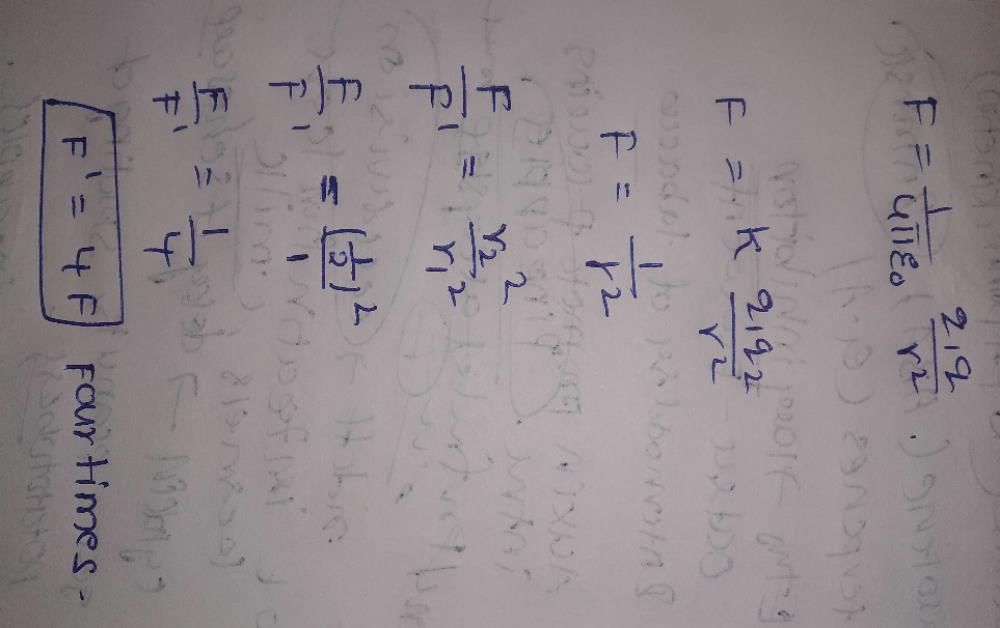All Exams >
NEET >
Weekly Tests for NEET Preparation >
All Questions
All questions of April Week 1 for NEET Exam
Can you explain the answer of this question below:The female gametophyte in angiosperm is
- A:
Ovule
- B:
Carpel
- C:
Embryo sac
- D:
Egg
The answer is c.
The female gametophyte in angiosperm is
Ovule
Carpel
Embryo sac
Egg

|
Aiims New Delhi answered |
Embryosacline of ncert in sexual reproduction in flowering plants chapter😀😀😀💯💯💯👍👍👍
Molality is expressed in- a)mol/kg
- b)mol/L
- c)L/mol
- d)g/L
Correct answer is option 'A'. Can you explain this answer?
Molality is expressed in
a)
mol/kg
b)
mol/L
c)
L/mol
d)
g/L

|
Siddharth Abimanyu answered |
Molality=moles of solute/kg of solvent... so option A
The force between two small charged spheres having charges 3 x 10-6C and 4 x 10-6C placed 40 cm apart in air is- a)67.5 x 10-3 N
- b)67.5 x 10-2 N
- c)6.75 x 10-1 N
- d)none
Correct answer is option 'C'. Can you explain this answer?
The force between two small charged spheres having charges 3 x 10-6C and 4 x 10-6C placed 40 cm apart in air is
a)
67.5 x 10-3 N
b)
67.5 x 10-2 N
c)
6.75 x 10-1 N
d)
none
|
|
Lavanya Menon answered |
Since the charges are unlike, the force will be attractive. Thus the force directs from 1C to -4C.
the molarity ofa solution obtained by mixing 750 ml of 0.5(M) hcl with 250ml of 2(M) hcl will be?- a)1.25 M
- b)2.5 M
- c)1.00 M
- d)0.875 M
Correct answer is option 'D'. Can you explain this answer?
the molarity ofa solution obtained by mixing 750 ml of 0.5(M) hcl with 250ml of 2(M) hcl will be?
a)
1.25 M
b)
2.5 M
c)
1.00 M
d)
0.875 M
|
|
Vilas Kumar answered |
M = M1V1+ M2V2 / V1+V2. M = 750*0.5+250*2 / 750+250. M = 875 / 1000. M = 0.875
Assertion: In monosporic development, all four megaspores produced from the megaspore mother cell (MMC) do not contribute to the formation of the female gametophyte.
Reason: Monosporic development results in the formation of four functional megaspores.
- a)Both the assertion and reason are true, and the reason is a correct explanation of the assertion.
- b)Both the assertion and reason are true, but the reason is not a correct explanation of the assertion.
- c)The assertion is true, but the reason is false.
- d)The assertion is false, but the reason is true.
Correct answer is option 'C'. Can you explain this answer?
Assertion: In monosporic development, all four megaspores produced from the megaspore mother cell (MMC) do not contribute to the formation of the female gametophyte.
Reason: Monosporic development results in the formation of four functional megaspores.
a)
Both the assertion and reason are true, and the reason is a correct explanation of the assertion.
b)
Both the assertion and reason are true, but the reason is not a correct explanation of the assertion.
c)
The assertion is true, but the reason is false.
d)
The assertion is false, but the reason is true.
|
|
Vijay Bansal answered |
Explanation: In monosporic development, only one megaspore out of the four produced from the megaspore mother cell (MMC) develops into the female gametophyte. The other three megaspores typically degenerate. Therefore, the assertion is correct. However, the reason is incorrect as it states that all four megaspores become functional, which is not the case in monosporic development.
Can you explain the answer of this question below: Mole fraction of ethyl chloride and methanol in a ternary solution is 0.6 and 0.32 respectively. What is the mole fraction of third component. Also identify the solvent in this ternary solution.
- A:
0.03, Ethyl chloride
- B:
0.08, cannot be determined
- C:
0.03, Methanol
- D:
0.08, Ethyl chloride
The answer is d.
Mole fraction of ethyl chloride and methanol in a ternary solution is 0.6 and 0.32 respectively. What is the mole fraction of third component. Also identify the solvent in this ternary solution.
0.03, Ethyl chloride
0.08, cannot be determined
0.03, Methanol
0.08, Ethyl chloride

|
Infinity Academy answered |
Mole fraction of third component is 1 - (0.6 + 0.32) = 0.08.
Since ethyl chloride has highest mole fraction so it is the solvent.
Since ethyl chloride has highest mole fraction so it is the solvent.
The number of moles of KCl in 3 L of 3 M solution is- a)27 moles
- b)1 moles
- c)9 moles
- d)3 moles
Correct answer is option 'C'. Can you explain this answer?
The number of moles of KCl in 3 L of 3 M solution is
a)
27 moles
b)
1 moles
c)
9 moles
d)
3 moles
|
|
Om Desai answered |
In 3M there will be 3 moles per litre therefore in 3 litres there will be 9 moles.
Two insulated charged copper spheres A and B have their centers separated by a distance of 50 cm. What is the mutual force of electrostatic repulsion if the charge on each is 6.5×10−7 C? The radii of A and B are negligible compared to the distance of separation.- a)4.5×10−2N
- b)2.5×10−2 N
- c)1.5×10−2 N
- d)3.5×10−2 N
Correct answer is option 'C'. Can you explain this answer?
Two insulated charged copper spheres A and B have their centers separated by a distance of 50 cm. What is the mutual force of electrostatic repulsion if the charge on each is 6.5×10−7 C? The radii of A and B are negligible compared to the distance of separation.
a)
4.5×10−2N
b)
2.5×10−2 N
c)
1.5×10−2 N
d)
3.5×10−2 N
|
|
Om Desai answered |
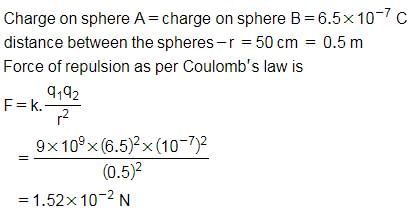
Cucurbits and coconuts are examples of _______.- a)Polycious
- b)Dioecious
- c)Trioecious
- d)Monoecious
Correct answer is option 'D'. Can you explain this answer?
Cucurbits and coconuts are examples of _______.
a)
Polycious
b)
Dioecious
c)
Trioecious
d)
Monoecious
|
|
Jhanvi Tiwari answered |
Cucurbits and coconuts are examples of Monoecious plants.
Explanation:
Monoecious plants are those which have separate male and female flowers on the same plant. The term "monoecious" is derived from two Greek words, "monos" meaning "single" and "oikos" meaning "house". In monoecious plants, both male and female flowers are present in the same "house" or plant.
Cucurbits, which include plants like cucumber, pumpkin, and watermelon, are monoecious. They produce separate male and female flowers on the same plant. The male flowers have long, thin stalks with a single anther, while the female flowers have a swollen base which will eventually develop into the fruit.
Coconuts are also monoecious. The male and female flowers are borne on the same inflorescence, which is a type of flower cluster. The male flowers are small and yellow while the female flowers are larger and green. Once pollinated, the female flowers develop into the coconut fruit.
Explanation:
Monoecious plants are those which have separate male and female flowers on the same plant. The term "monoecious" is derived from two Greek words, "monos" meaning "single" and "oikos" meaning "house". In monoecious plants, both male and female flowers are present in the same "house" or plant.
Cucurbits, which include plants like cucumber, pumpkin, and watermelon, are monoecious. They produce separate male and female flowers on the same plant. The male flowers have long, thin stalks with a single anther, while the female flowers have a swollen base which will eventually develop into the fruit.
Coconuts are also monoecious. The male and female flowers are borne on the same inflorescence, which is a type of flower cluster. The male flowers are small and yellow while the female flowers are larger and green. Once pollinated, the female flowers develop into the coconut fruit.
Mole fraction of glycerine, C3H5(OH)3 in a solution containing 36 gm of water and 46 gm of glycerine is:- a)0.40
- b)0.20
- c)0.46
- d)0.36
Correct answer is option 'B'. Can you explain this answer?
Mole fraction of glycerine, C3H5(OH)3 in a solution containing 36 gm of water and 46 gm of glycerine is:
a)
0.40
b)
0.20
c)
0.46
d)
0.36
|
|
Naina Bansal answered |
No. of moles of glycerine= 46/92 (where 92 is M.M. of glycerine)
= 0.5moles
no. of moles of water= 36/18(where 18 is M.M. of water)
= 2moles
so mole fraction oh glycerine = No. of moles of glycerine/No. of moles of glycerine + No. of moles of water
= 0.5/2 + 0.5
= 0.20
Filiform apparatus is a characteristic feature of- a)Synergid
- b)Egg
- c)Suspensor
- d)Zygote
Correct answer is option 'A'. Can you explain this answer?
Filiform apparatus is a characteristic feature of
a)
Synergid
b)
Egg
c)
Suspensor
d)
Zygote
|
|
Vijay Bansal answered |
Filiform apparatus are finger-like projections present at the micropylar end of synergids of embryo sac.
Mole fraction of ethyl chloride and methanol in a ternary solution is 0.6 and 0.32 respectively. What is the mole fraction of third component. Also identify the solvent in this ternary solution.- a)0.03, Ethyl chloride
- b)0.08, cannot be determined
- c)0.03, Methanol
- d)0.08, Ethyl chloride
Correct answer is option 'D'. Can you explain this answer?
Mole fraction of ethyl chloride and methanol in a ternary solution is 0.6 and 0.32 respectively. What is the mole fraction of third component. Also identify the solvent in this ternary solution.
a)
0.03, Ethyl chloride
b)
0.08, cannot be determined
c)
0.03, Methanol
d)
0.08, Ethyl chloride

|
Anu answered |
•sum of mole fractions are always 1.so mole fraction of 3rd component =1-(0.6+0.32)=0.8 • solvent is the component of a solution that is present in the greatest amount. so ethyl chloride is solvent
A uniform line charge with linear density λ lies along the y-axis. What flux crosses a spherical surface cantered at the origin with r = R- a)2Rλ/ε0
- b)Rλ/ε0
- c)λ/ε0
- d)none of the above
Correct answer is option 'A'. Can you explain this answer?
A uniform line charge with linear density λ lies along the y-axis. What flux crosses a spherical surface cantered at the origin with r = R
a)
2Rλ/ε0
b)
Rλ/ε0
c)
λ/ε0
d)
none of the above
|
|
Neha Chauhan answered |
Total charge inside the spherical surface =2Rλ
∫E.dS = qin/ε0
So flux = 2Rλ/ε0
Hence answer is (a)
∫E.dS = qin/ε0
So flux = 2Rλ/ε0
Hence answer is (a)
Embryo sac represents:
- a)Megagametophyte
- b)Megasporangium
- c)Microgametophyte
- d)Microsporangium
Correct answer is option 'A'. Can you explain this answer?
Embryo sac represents:
a)
Megagametophyte
b)
Megasporangium
c)
Microgametophyte
d)
Microsporangium
|
|
Vijay Bansal answered |
The female gametophyte specifically termed a megagametophyte is also called the embryo sac in angiosperms. The megagametophyte produces an egg cell (or several in some groups) for the purpose of fertilization.
The level of contamination of chloroform was found to be 15 ppm. It means 15 g of chloroform is present in how many grams of solution?- a)1000 g
- b)106 g
- c)100 g
- d)1.0 g
Correct answer is option 'B'. Can you explain this answer?
The level of contamination of chloroform was found to be 15 ppm. It means 15 g of chloroform is present in how many grams of solution?
a)
1000 g
b)
106 g
c)
100 g
d)
1.0 g
|
|
Lavanya Menon answered |
1 ppm is equivalent to 1 part out of 1 million (106) parts.
∴ Mass percent of 15 ppm chloroform in water
∴ Mass percent of 15 ppm chloroform in water

⇒ 1.5 x 10-3 g chloroform present in 100 g water
Thus, 15g chloroform will be present in water
Thus, 15g chloroform will be present in water

Ratio of the permittivity of medium to the permittivity of free space is known as
- a)Dielectric ratio
- b)Dielectric permittivity
- c)Dielectric constant
- d)Dielectric medium
Correct answer is option 'C'. Can you explain this answer?
Ratio of the permittivity of medium to the permittivity of free space is known as
a)
Dielectric ratio
b)
Dielectric permittivity
c)
Dielectric constant
d)
Dielectric medium
|
|
Hansa Sharma answered |
The ratio of a medium's permittivity to the permittivity of free space is known as the dielectric constant or relative permittivity. The equation for relative permittivity is κ = ϵ/ϵ0, where ϵ is the permittivity of the medium and ϵ0 is the permittivity of free space. Both permittivity and the permittivity of free space have the same unit, farads per meter (F/m), so the dielectric constant is dimensionless.
Can you explain the answer of this question below: Calculate the molality of 12.5% w/w sulphuric acid?
- A:
2.85m
- B:
3.15m
- C:
1.45m
- D:
2.50m
The answer is c.
Calculate the molality of 12.5% w/w sulphuric acid?
2.85m
3.15m
1.45m
2.50m
|
|
Arun Khanna answered |
12.5% w/w means 12.5 g in 100 g of solution.
Weight of solvent = 100 g – 12.5 g= 87.5 g. Number of moles of sulphuric acid = 12.5/ 98 =0.127 mol
So molality = 0.127 X 1000/87.5 = 1.45 m
The mass of sodium chloride in 2.5 M solution is- a)37.80 g
- b)146.25 g
- c)117 .00g
- d)58.50 g
Correct answer is option 'B'. Can you explain this answer?
The mass of sodium chloride in 2.5 M solution is
a)
37.80 g
b)
146.25 g
c)
117 .00g
d)
58.50 g
|
|
Rajeev Saxena answered |
For preparing one molar solution we are required to dissolve one mole of the NaCl ( 58.5g) , for 2.5 mol we require 2.5 * 58.5= 146.25 g
Can you explain the answer of this question below:Starting from the innermost part, the correct sequence of parts in an ovule are
- A:
Egg, integument, embryo sac and nucellus.
- B:
Egg, embryo sac, nucellus and integument.
- C:
Embryo sac, nucellus, integument and egg.
- D:
Egg, nucellus, embryo sac and integument.
The answer is b.
Starting from the innermost part, the correct sequence of parts in an ovule are
Egg, integument, embryo sac and nucellus.
Egg, embryo sac, nucellus and integument.
Embryo sac, nucellus, integument and egg.
Egg, nucellus, embryo sac and integument.
|
|
Preethi Saha answered |
The correct sequence of parts in an ovule starting from the innermost part is:
Egg, embryo sac, nucellus and integument.
Explanation:
• An ovule is a structure present in the ovary of a flower that contains the female reproductive cells.
• The ovule is composed of different parts, each playing a specific role in pollination and fertilization.
• The innermost part of the ovule is the egg cell, which is the female gamete.
• The egg cell is surrounded by the embryo sac, which is a structure that contains the synergids, antipodal cells, and the central cell.
• The central cell contains two nuclei, which will fuse with the sperm nuclei during fertilization to form the endosperm.
• The embryo sac is surrounded by the nucellus, which is the tissue that supplies nutrients to the developing embryo.
• The nucellus is surrounded by the integuments, which are two layers of tissue that form the outer covering of the ovule.
• The integuments develop into the seed coat after fertilization.
Therefore, the correct sequence of parts in an ovule starting from the innermost part is egg, embryo sac, nucellus and integument.
Egg, embryo sac, nucellus and integument.
Explanation:
• An ovule is a structure present in the ovary of a flower that contains the female reproductive cells.
• The ovule is composed of different parts, each playing a specific role in pollination and fertilization.
• The innermost part of the ovule is the egg cell, which is the female gamete.
• The egg cell is surrounded by the embryo sac, which is a structure that contains the synergids, antipodal cells, and the central cell.
• The central cell contains two nuclei, which will fuse with the sperm nuclei during fertilization to form the endosperm.
• The embryo sac is surrounded by the nucellus, which is the tissue that supplies nutrients to the developing embryo.
• The nucellus is surrounded by the integuments, which are two layers of tissue that form the outer covering of the ovule.
• The integuments develop into the seed coat after fertilization.
Therefore, the correct sequence of parts in an ovule starting from the innermost part is egg, embryo sac, nucellus and integument.
The force between two charges is 120 N. If the distance between the charges is doubled, the force will be- a)60 N
- b)30 N
- c)40 N
- d)15 N
Correct answer is option 'B'. Can you explain this answer?
The force between two charges is 120 N. If the distance between the charges is doubled, the force will be
a)
60 N
b)
30 N
c)
40 N
d)
15 N
|
|
Gaurav Kumar answered |
Coulombs law states the force between two charged particles is directly proportional to the product of charges and inversely proportional to the square of distance between them.
So if the distance is doubled then the force would decrease 4 times.
So the new force would be 120/4=30 Newton.
So if the distance is doubled then the force would decrease 4 times.
So the new force would be 120/4=30 Newton.
Calculate the molality of 12.5% w/w sulphuric acid?- a)2.85m
- b)3.15m
- c)1.45m
- d)2.50m
Correct answer is option 'C'. Can you explain this answer?
Calculate the molality of 12.5% w/w sulphuric acid?
a)
2.85m
b)
3.15m
c)
1.45m
d)
2.50m
|
|
Nandini Patel answered |
12.5% w/w means 12.5 g in 100 g of solution.
Weight of solvent = 100 g – 12.5 g= 87.5 g. Number of moles of sulphuric acid = 12.5/ 98 =0.127 mol
So molality = 0.127x1000/87.5 = 1.45 m
A sample of 300.0 g of drinking water is found to contain 38 mg Pb. What this concentration in parts per million?- a)3 x 102 ppm
- b)6.5 m
- c)130 ppm Pb
- d)21 ppm
Correct answer is option 'C'. Can you explain this answer?
A sample of 300.0 g of drinking water is found to contain 38 mg Pb. What this concentration in parts per million?
a)
3 x 102 ppm
b)
6.5 m
c)
130 ppm Pb
d)
21 ppm
|
|
Mira Sharma answered |
We use parts per million to express the concentrations of solutions that contain very, very small amounts, often called trace amounts, of a given solute.
More specifically, a solution's concentration in parts per millions tells you the number of parts of solute present for every
10^6=1,000,000
parts of solution. You can thus say that a 1 ppm
solution will contain exactly 1 g of solute for every 10^6g of solution.
In this case, you know that you have
38 mg Pb x (1 g/10^3 mg) = 3.8 x 10^-2 g Pb
in exactly
300.0 g = 3.000 x 10^2 g solution
This means that you can use this known composition as a conversion factor to scale up the mass of the solution to
10^6 g solution x (3.8 x 10^-2 g Pb/3.000 x 10^2 g solution)
= 130 g solution
Since this represents the mass of lead present in exactly 10^6 g of solution, you can say that the solution has a concentration of:
concentration (ppm) = 130 ppm Pb
Two positive charges - a)repel each other
- b)attract each other at times and repel at other times
- c)attract each other
- d)always attract each other
Correct answer is option 'A'. Can you explain this answer?
Two positive charges
a)
repel each other
b)
attract each other at times and repel at other times
c)
attract each other
d)
always attract each other

|
Ramesh Chand answered |
In contrast to the attractive force between 2 objects with opposite charges , two objects that are of like charge will repel eachother. That is , a positively charged object will exert a repulsive force upon a second positively charged object. This repulsive force will push the two object apart.
An infinite number of charges, each equal to 4C, are placed along the x-axis at x = 1 m, x = 2 m, x = 4 m, x = 8 m and so on. The total force on a charge of 1C placed at the origin is- a)48 × 10 8 N
- b)4.8 × 10 9 N
- c)48 × 10 4 N
- d)4.8 × 10 10 N
Correct answer is 'D'. Can you explain this answer?
An infinite number of charges, each equal to 4C, are placed along the x-axis at x = 1 m, x = 2 m, x = 4 m, x = 8 m and so on. The total force on a charge of 1C placed at the origin is
a)
48 × 10 8 N
b)
4.8 × 10 9 N
c)
48 × 10 4 N
d)
4.8 × 10 10 N
|
|
Nabanita Sen answered |
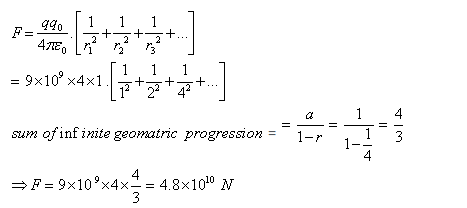
An infinite number of charges, each equal to 4C, are placed along the x-axis at x = 1 m, x = 2 m, x = 4 m, x = 8 m and so on. The total force on a charge of 1C placed at the origin is- a)48 × 10 8 N
- b)4.8 × 10 9 N
- c)48 × 10 4 N
- d)4.8 × 10 10 N
Correct answer is option 'D'. Can you explain this answer?
An infinite number of charges, each equal to 4C, are placed along the x-axis at x = 1 m, x = 2 m, x = 4 m, x = 8 m and so on. The total force on a charge of 1C placed at the origin is
a)
48 × 10 8 N
b)
4.8 × 10 9 N
c)
48 × 10 4 N
d)
4.8 × 10 10 N
|
|
Nandini Patel answered |
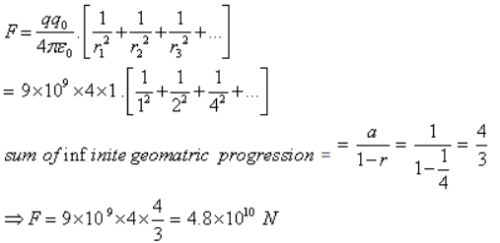
Electrostatic force is - a)force exerted by an electron on a neutron
- b)force exerted by one charge on another when the two are at rest in a given frame of reference
- c)force exerted by one charge on another when the two are moving in a given frame of reference
- d)force exerted by one charge on another when the two are accelerating in a given frame of reference
Correct answer is option 'B'. Can you explain this answer?
Electrostatic force is
a)
force exerted by an electron on a neutron
b)
force exerted by one charge on another when the two are at rest in a given frame of reference
c)
force exerted by one charge on another when the two are moving in a given frame of reference
d)
force exerted by one charge on another when the two are accelerating in a given frame of reference
|
|
Rhea Iyer answered |
Electrostatics means charges at rest, or relatively at rest so this force can be applicable only when charge produce electric field which is constant which is possible only when charges at rest or relatively at rest.
Sporopollenin an organic material is present in- a)Exine
- b)Intine
- c)Style
- d)Stigma
Correct answer is option 'A'. Can you explain this answer?
Sporopollenin an organic material is present in
a)
Exine
b)
Intine
c)
Style
d)
Stigma
|
|
Ritu Joshi answered |
The exine is made up of sporopollenin, which is one of the most resistant organic material. The in tine layer is made up of cellulose and pectin materials.The exine is hard and hence protects the pollen grains during adverse conditions.
Under the influence of the coulomb field of charge +Q, a charge −q is moving around it in an elliptical orbit. Find out the correct statement(s). - a)The linear momentum of the charge −q is constant
- b)The angular velocity of the charge −q is constant
- c)The angular momentum of the charge −q is constant
- d)The linear speed of the charge −q is constant
Correct answer is option 'C'. Can you explain this answer?
Under the influence of the coulomb field of charge +Q, a charge −q is moving around it in an elliptical orbit. Find out the correct statement(s).
a)
The linear momentum of the charge −q is constant
b)
The angular velocity of the charge −q is constant
c)
The angular momentum of the charge −q is constant
d)
The linear speed of the charge −q is constant
|
|
Shraddha Dey answered |
Since the charge –q is moving in elliptical orbit so to make its motion stable the total angular momentum of the charge is constant since it experience a centripetal force from the charge +Q so it follow the motion as the motion of earth around sun.
Mole fraction of ethyl chloride and methanol in a ternary solution is 0.6 and 0.32 respectively. What is the mole fraction of third component. Also identify the solvent in this ternary solution.- a)0.03, Ethyl chloride
- b)0.08, cannot be determined
- c)0.03, Methanol
- d)0.08, Ethyl chloride
Correct answer is 'D'. Can you explain this answer?
Mole fraction of ethyl chloride and methanol in a ternary solution is 0.6 and 0.32 respectively. What is the mole fraction of third component. Also identify the solvent in this ternary solution.
a)
0.03, Ethyl chloride
b)
0.08, cannot be determined
c)
0.03, Methanol
d)
0.08, Ethyl chloride

|
Maitri Sharma answered |
Mole fraction of third component is 1-(0.6 + 0.32) = 0.08. Since ethyl chloride has highest mole fraction so it is the solvent.
Which tissue is required to be present in between stock and scion during grafting?- a)Xylem
- b)Phloem
- c)Meristem
- d)Parenchyma.
Correct answer is 'B'. Can you explain this answer?
Which tissue is required to be present in between stock and scion during grafting?
a)
Xylem
b)
Phloem
c)
Meristem
d)
Parenchyma.
|
|
Anjali Iyer answered |
Phloem, also called bast, tissues in plants that conduct foods made in the leaves to all other parts of the plant. Phloem is composed of various specialized cells called sieve tubes, companion cells, phloem fibres, and phloem parenchyma cells. Primary phloem is formed by the apical meristems (zones of new cell production) of root and shoot tips; it may be either protophloem, the cells of which are matured before elongation (during growth) of the area in which it lies, or metaphloem, the cells of which mature after elongation. Sieve tubes of protophloem are unable to stretch with the elongating tissues and are torn and destroyed as the plant ages. The other cell types in the phloem may be converted to fibres. The later maturing metaphloem is not destroyed and may function during the rest of the plant’s life in plants such as palms but is replaced by secondary phloem in plants that have a cambium.
Select the correct statement about the following diagram -
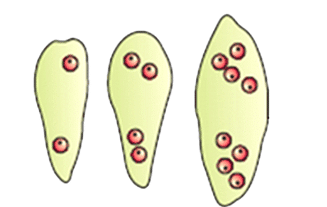
Statement I: It shows the two, four, and eighth nucleate stages of the embryo sac.
Statement II: The divisions are mitotic and free nuclear.- a)Statement I is correct, Statement II is correct
- b)Statement I is incorrect, Statement II is correct
- c)Statement I is correct, Statement II is incorrect
- d)Statement I is incorrect, Statement II is incorrect
Correct answer is option 'A'. Can you explain this answer?
Select the correct statement about the following diagram -

Statement I: It shows the two, four, and eighth nucleate stages of the embryo sac.
Statement II: The divisions are mitotic and free nuclear.

Statement I: It shows the two, four, and eighth nucleate stages of the embryo sac.
Statement II: The divisions are mitotic and free nuclear.
a)
Statement I is correct, Statement II is correct
b)
Statement I is incorrect, Statement II is correct
c)
Statement I is correct, Statement II is incorrect
d)
Statement I is incorrect, Statement II is incorrect

|
Bs Academy answered |
Here's a detailed explanation:
- The diagram depicts the different stages of embryo sac development.
- Statement I is correct because it accurately describes the content of the diagram, showing two, four, and eight nucleate stages of the embryo sac.
- Statement II is correct as the divisions in embryo sac development are typically free nuclear.
Topic in NCERT: Formation of the Embryo Sac
Line in NCERT: "The nucleus of the functional megaspore divides mitotically to form two nuclei which move to the opposite poles, forming the 2-nucleate embryo sac. Two more sequential mitotic nuclear divisions result in the formation of the 4-nucleate and later the 8-nucleate stages of the embryo sac. It is of interest to note that these mitotic divisions are strictly free nuclear, that is, nuclear divisions are not followed immediately by cell wall formation."
- The diagram depicts the different stages of embryo sac development.
- Statement I is correct because it accurately describes the content of the diagram, showing two, four, and eight nucleate stages of the embryo sac.
- Statement II is correct as the divisions in embryo sac development are typically free nuclear.
Topic in NCERT: Formation of the Embryo Sac
Line in NCERT: "The nucleus of the functional megaspore divides mitotically to form two nuclei which move to the opposite poles, forming the 2-nucleate embryo sac. Two more sequential mitotic nuclear divisions result in the formation of the 4-nucleate and later the 8-nucleate stages of the embryo sac. It is of interest to note that these mitotic divisions are strictly free nuclear, that is, nuclear divisions are not followed immediately by cell wall formation."
Identify A-D in the given enlarged view of one microsporangium showing wall layers: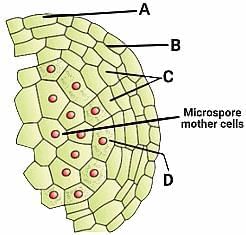
- a)A. Epidermis B. Endothecium C. Middle layers D,Tapetum
- b)A. Epidermis B. Middle Layer C. Endothecium D. Tapetum
- c)A.Endothelium B.Epidermis C.Tapetum D.Miidle Layer
- d)AEpithelium. B.Endothelium C.Tapetum D.Middle layers
Correct answer is option 'A'. Can you explain this answer?
Identify A-D in the given enlarged view of one microsporangium showing wall layers:

a)
A. Epidermis B. Endothecium C. Middle layers D,Tapetum
b)
A. Epidermis B. Middle Layer C. Endothecium D. Tapetum
c)
A.Endothelium B.Epidermis C.Tapetum D.Miidle Layer
d)
AEpithelium. B.Endothelium C.Tapetum D.Middle layers

|
Stepway Academy answered |
The correct answer is: (A)
In the given enlarged view of the microsporangium, the layers are identified as follows:
- A: Epidermis - the outermost protective layer
- B: Endothecium - the specialized cell layer surrounding the sporogenous tissue
- C: Middle layers - various layers lying between the endothecium and tapetum
- D: Tapetum - the innermost layer responsible for nourishing developing pollen grains
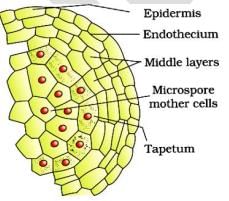
Topic in NCERT: Anther Structure
Line in NCERT: "four wall layers (Figure 1.3b)- the epidermis, endothecium, middle layers and the tapetum."
In the given enlarged view of the microsporangium, the layers are identified as follows:
- A: Epidermis - the outermost protective layer
- B: Endothecium - the specialized cell layer surrounding the sporogenous tissue
- C: Middle layers - various layers lying between the endothecium and tapetum
- D: Tapetum - the innermost layer responsible for nourishing developing pollen grains

Topic in NCERT: Anther Structure
Line in NCERT: "four wall layers (Figure 1.3b)- the epidermis, endothecium, middle layers and the tapetum."
Study the stages of maturation of microspore into a pollen grain and select the correct statements:
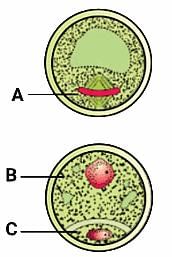
Statement I: The spindle formation as seen in A is strictly symmetric.
Statement II: The larger cell [B] is the generative cell and the smaller cell [C] is the vegetative cell.- a)Statement I is correct, Statement II is correct
- b)Statement I is incorrect, Statement II is correct
- c)Statement I is correct, Statement II is incorrect
- d)Statement I is incorrect, Statement II is incorrect
Correct answer is option 'D'. Can you explain this answer?
Study the stages of maturation of microspore into a pollen grain and select the correct statements:

Statement I: The spindle formation as seen in A is strictly symmetric.
Statement II: The larger cell [B] is the generative cell and the smaller cell [C] is the vegetative cell.

Statement I: The spindle formation as seen in A is strictly symmetric.
Statement II: The larger cell [B] is the generative cell and the smaller cell [C] is the vegetative cell.
a)
Statement I is correct, Statement II is correct
b)
Statement I is incorrect, Statement II is correct
c)
Statement I is correct, Statement II is incorrect
d)
Statement I is incorrect, Statement II is incorrect

|
Stepway Academy answered |
The correct answer is: D: Statement I is incorrect, Statement II is incorrect.
- The spindle formation as seen in Asymmetric during microspore maturation.
- The larger cell (B) is the vegetative cell, and the smaller cell (C) is the generative cell.
- The spindle formation as seen in Asymmetric during microspore maturation.
- The larger cell (B) is the vegetative cell, and the smaller cell (C) is the generative cell.
Diagram from NCERT:
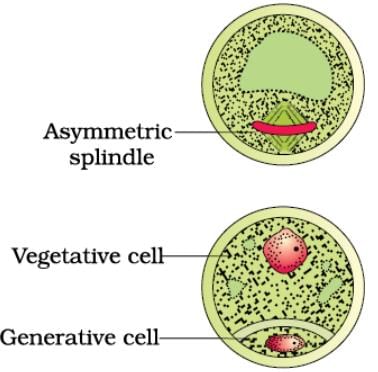
Chapter doubts & questions for April Week 1 - Weekly Tests for NEET Preparation 2025 is part of NEET exam preparation. The chapters have been prepared according to the NEET exam syllabus. The Chapter doubts & questions, notes, tests & MCQs are made for NEET 2025 Exam. Find important definitions, questions, notes, meanings, examples, exercises, MCQs and online tests here.
Chapter doubts & questions of April Week 1 - Weekly Tests for NEET Preparation in English & Hindi are available as part of NEET exam.
Download more important topics, notes, lectures and mock test series for NEET Exam by signing up for free.


